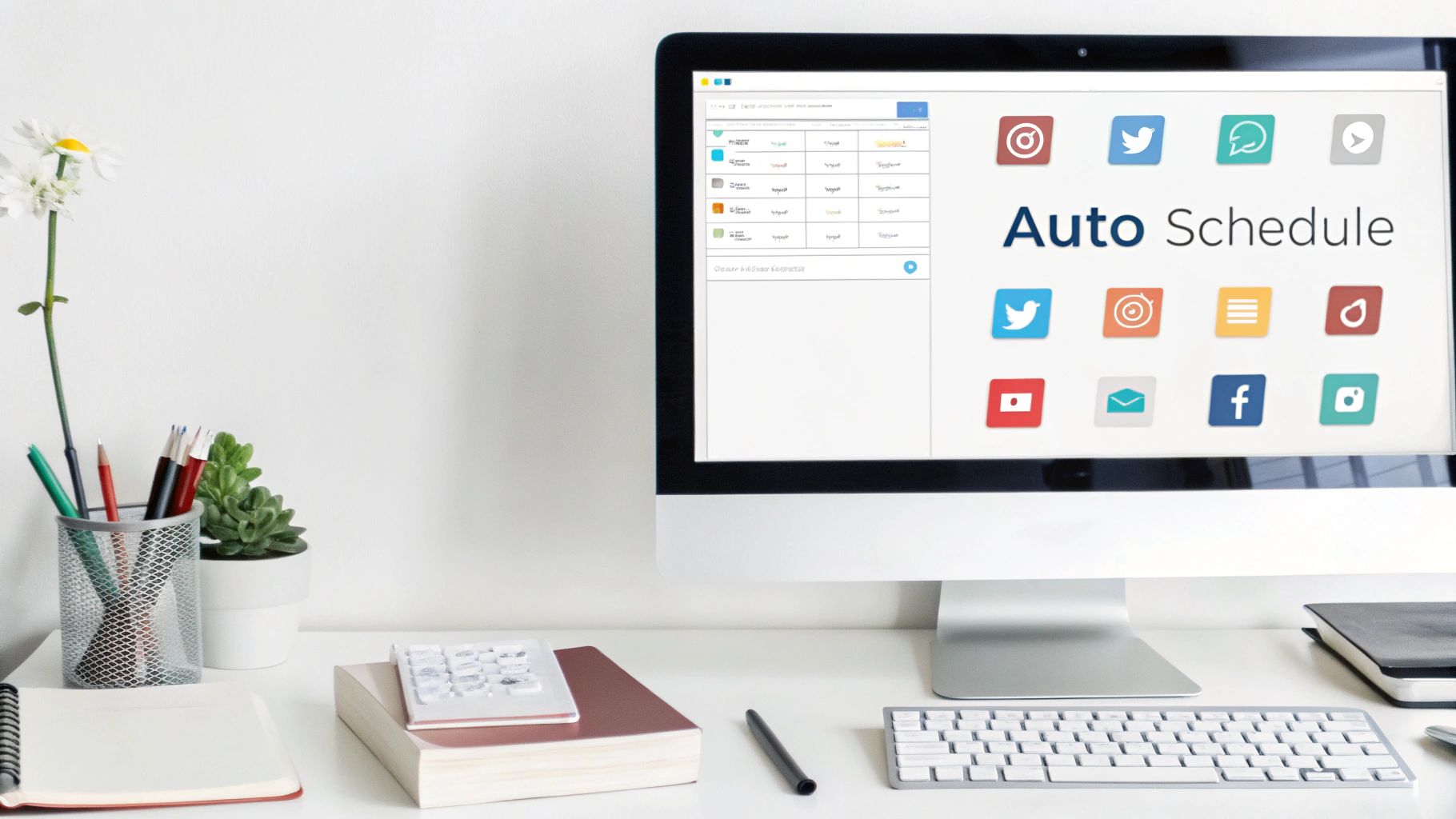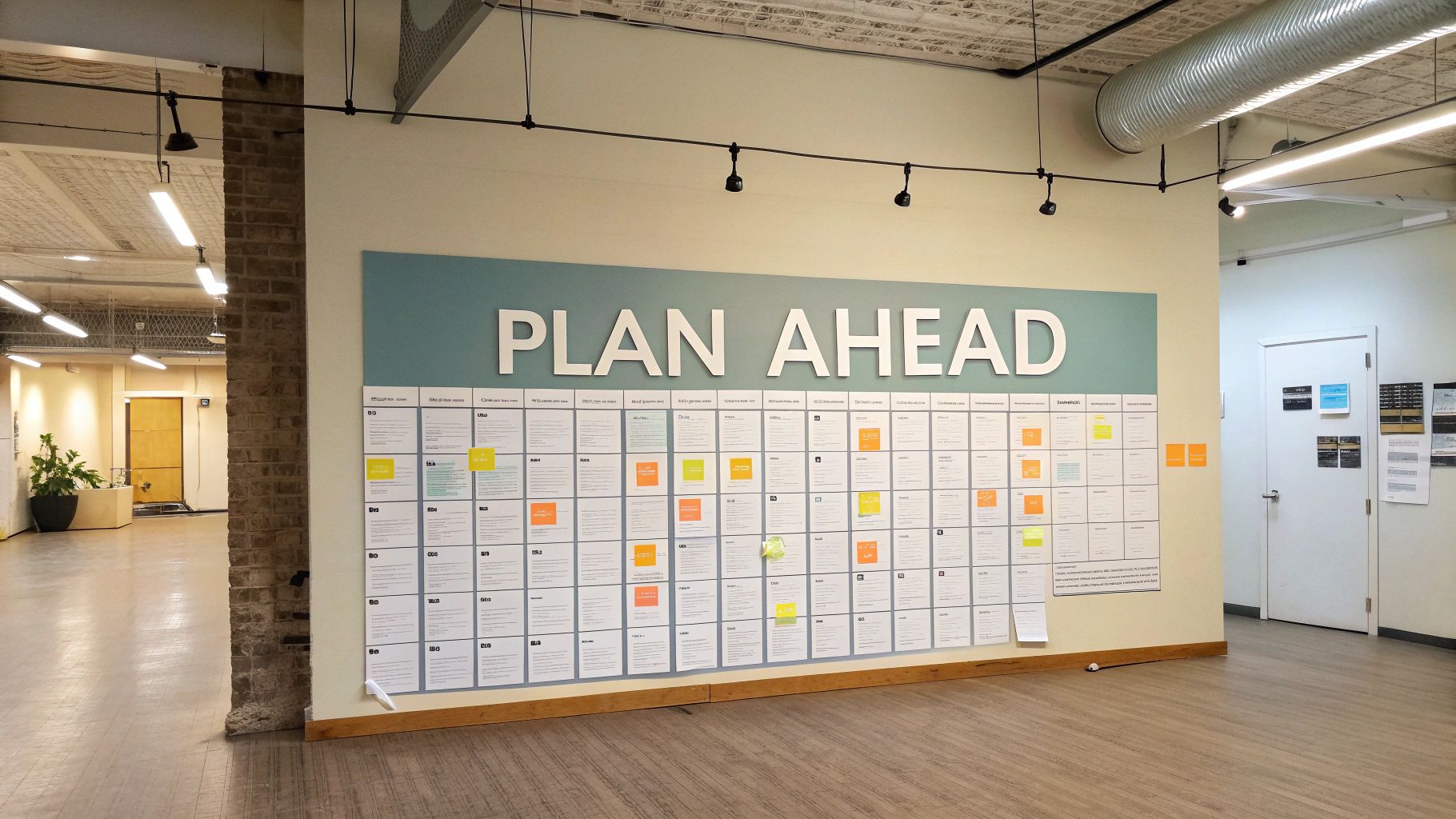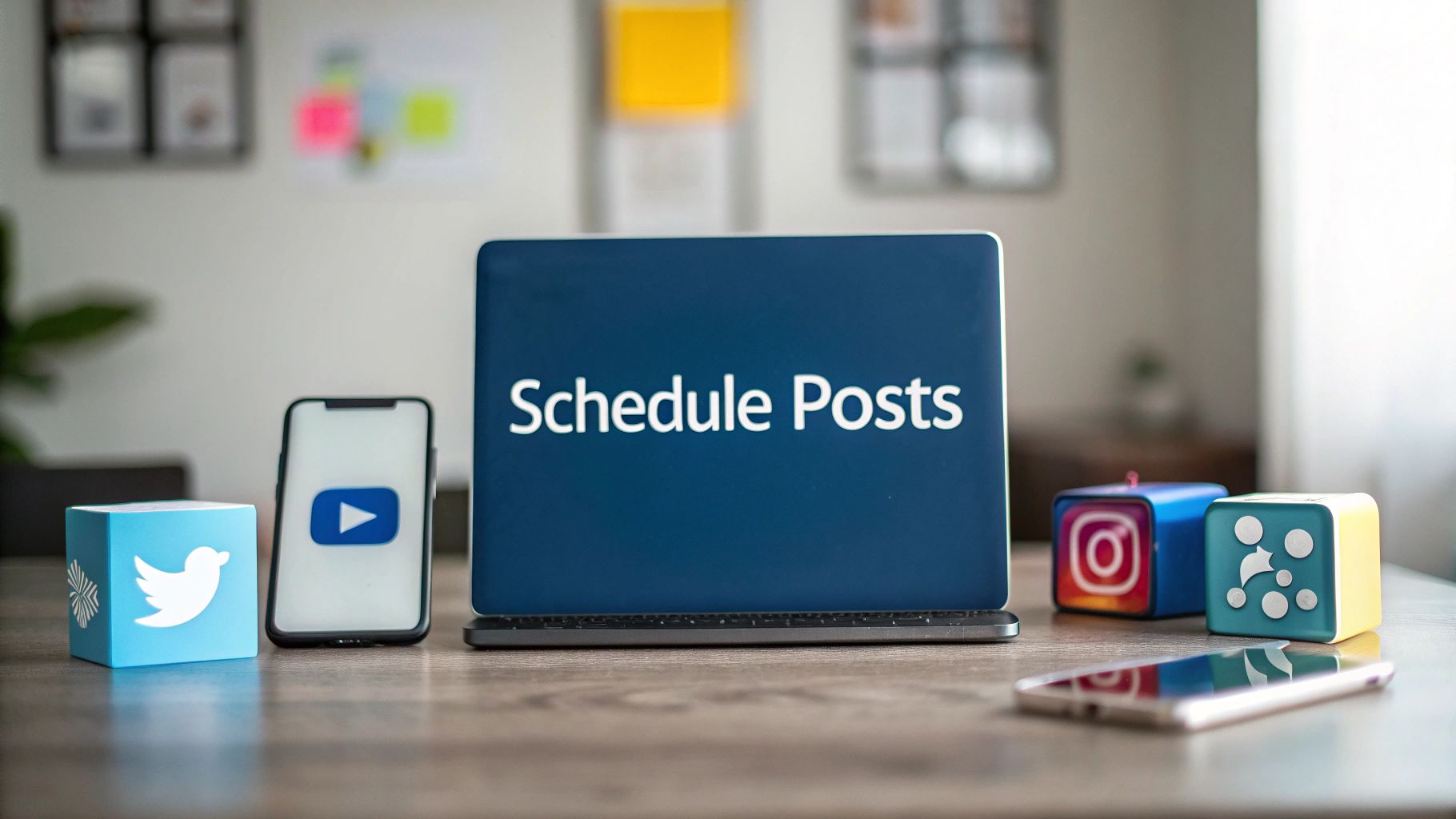Expert Tips to Schedule Social Media Posts
Why Scheduling Social Media Posts Is No Longer Optional

Maintaining a consistent social media presence can be challenging, especially when managing multiple platforms. Scheduling social media posts, once a handy extra, is now essential for businesses of all sizes. This change is due to how online engagement works and the sheer amount of content competing for attention.
Think about connecting with a global audience. Peak engagement times differ drastically across time zones. Manually posting at the best time for each region isn't realistic. Scheduling, however, lets businesses target these times, maximizing visibility and impact. Your content reaches the right people at the right time, no matter where they are.
The growing volume of online content also demands a proactive strategy. Social media algorithms reward consistency. Scheduling facilitates a regular posting rhythm, keeping your brand visible and strengthening your presence in busy feeds. It's like having a dedicated team working around the clock.
Social media's massive user base makes scheduling crucial. Over 5.24 billion people use social media worldwide as of January 2025. The average user accesses 6.83 platforms monthly. This highlights the importance of strategic timing and content management across platforms to boost engagement. Scheduling posts helps businesses maintain a consistent presence and reach their audience effectively during peak times, like weekday mornings and afternoons. Find more detailed statistics here.
The Psychological Benefits of Scheduling
Scheduling offers psychological advantages too. The pressure to constantly create new content can cause burnout and hinder strategic thinking. Planning ahead frees up mental energy for more creative content development.
Pre-planned content also allows for more thoughtful interaction. Instead of rushing to react, social media managers can focus on building real connections with their audience. This creates a more authentic online experience, ultimately strengthening brand loyalty. New to scheduling? This guide provides a helpful introduction: how to schedule social media posts.
Scheduling for Resource-Strapped Teams
Even small teams with limited resources can benefit from scheduling. By setting aside a few hours each week to plan and schedule content, these teams can maintain a consistent online presence without feeling overwhelmed. They can then focus on other essential tasks, like community engagement and customer service. Scheduling helps businesses work smarter, not harder, in the dynamic world of social media.
The Ultimate Toolkit: Top Scheduling Platforms Compared

Picking the right social media scheduling platform can have a big impact on your success. Different platforms work best for different situations, from small businesses to large corporations. Understanding each platform’s strengths is key to making a good choice. Some tools are great for team collaboration, while others focus on visual planning or detailed analytics.
Key Features to Consider When Choosing a Scheduling Tool
When you're looking at different scheduling platforms, keep some key features in mind. A robust content calendar is vital for seeing your posting schedule and staying consistent. Collaboration tools make teamwork and feedback much easier, which is especially helpful for bigger teams. A smooth approval workflow helps manage content reviews and keeps your brand consistent. And don't forget about platform integrations. Your tool should easily connect with all the social media channels you use.
Comparing Top Social Media Scheduling Platforms
Several top platforms excel at social media scheduling, each with its own perks. To help you find your way, we've put together a comparison table showing the key aspects of popular tools. You may find this helpful: How to master social media with management tools.
To make your decision easier, we've compiled a table comparing several popular social media scheduling tools. This table highlights key features, supported platforms, and pricing to give you a comprehensive overview.
| Tool | Best For | Supported Platforms | Key Features | Pricing Tier | Analytics Capabilities |
|---|---|---|---|---|---|
| Planable | Teams, collaboration, approvals | Facebook, Instagram, LinkedIn, Twitter, etc. | Visual calendar, custom approval workflows, AI writing assistant | Varies | Robust |
| Hootsuite | Managing multiple accounts | Most major platforms | Social inbox, OwlyAI content generation | Varies | Comprehensive |
| Sprout Social | Enterprise-level features, in-depth analytics | Most major platforms | Comprehensive analytics, social listening, review management | Varies | Advanced |
| Buffer | Small businesses, eCommerce | Most major platforms, Shopify | Shopify integration, affordable pricing, AI assistant | Varies | Standard |
| Later | Visual content, Instagram, TikTok | Instagram, Facebook, TikTok, Pinterest, etc. | Visual planner, hashtag suggestions, first comment scheduling | Varies | Basic |
| SocialBee | Content curation, AI strategy tools | Most major platforms (Bluesky, Threads, etc.) | RSS feeds, Category queues, Hashtag Collections, AI generated social strategy | Varies | Comprehensive |
| Pallyy | Agencies, visual content, bulk scheduling | Instagram, TikTok, etc | Content queues, Instagram feed preview, hashtag tool, visual drag-and-drop | Varies | Standard |
| Sendible | Agencies, client management | Most major platforms | Canva integration, client dashboards, content queues, white-labeling | Varies | Comprehensive |
| Agorapulse | Agencies, social listening, reporting | Facebook, Instagram, TikTok, Twitter, etc | Unified inbox, social media monitoring, Canva integration, AI writing assistant | Varies | Advanced |
| Hopper HQ | Small businesses, visual scheduling | Instagram, Facebook, Twitter, LinkedIn, TikTok | Drag and drop calendar, auto-posting, hashtag research, Grid Planner | Varies | Standard |
| Metricool | Data-driven marketers, competitor analysis | Most major platforms, Twitch, TikTok | Best-time-to-post overlay, batch scheduling, autolists, link shortener | Varies | Advanced |
As you can see, each tool offers different features and caters to various needs. Consider which aspects are most important to your social media strategy when making your selection.
Choosing the Right Tool for Your Needs
Finding the right scheduling tool depends on what you need and what's most important to you. If teamwork and approvals are essential, Planable could be a great option. But if you’re a visual brand focused on Instagram and TikTok, Later or Pallyy might be a better fit. For businesses on a budget, Buffer is a cost-effective choice with all the essentials. The best tool is the one that works smoothly with your process and helps you reach your social media goals. Think about your team’s size, your budget, and the specific features you need.
Building Your Content Calendar That Actually Works

Successfully scheduling social media posts begins with a well-structured content calendar. This isn't just a simple spreadsheet; it's the roadmap for your social media strategy. A content calendar helps you plan content, maintain a consistent brand voice, and incorporate important events in a natural way.
Frameworks For Effective Content Mapping
A good content calendar finds the balance between planning and flexibility. Start by mapping content across your chosen platforms. Think about what each platform does best. Instagram is great for visual storytelling, while Twitter is better for quick updates and conversations. For a deeper dive into creating a content calendar, check out this guide on How to master your social media content calendar.
Keep your content fresh by using a variety of formats. Mix images, videos, text posts, and even live streams to keep your audience engaged and cater to different preferences.
Batch Creation And Repurposing Content
Many successful brands batch create their content. This means setting aside dedicated time to produce multiple posts at once. Batching increases efficiency and ensures a consistent flow of content. For example, you could create all your social media graphics for the week in one go.
While planning is key, stay adaptable. Include buffer periods in your calendar. These open slots allow you to post about trending topics or react to current events, keeping your content relevant and timely.
Repurposing content is another way to maximize your efforts. A single blog post can be transformed into a series of tweets, Instagram graphics, or even a short video. This expands the reach of your core content and saves valuable time.
Adaptable Templates and Sustainability
Content calendars should be adaptable to your needs. A small business requires a different approach than a large corporation. Find templates that fit your specific growth stage. Don't strive for unrealistic perfection. A sustainable content schedule is more effective than a complex, unsustainable one.
Prioritizing Key Events And Themes
Integrate seasonal events and important dates relevant to your industry. Plan content around holidays, product launches, or industry conferences. This shows you're in tune with your audience and provides opportunities for targeted campaigns. A fitness brand, for example, might create content around New Year's resolutions.
Finally, remember your content calendar is a living document. Regularly review and adjust it based on performance data and audience feedback. This continuous optimization is essential for long-term social media success. By using these strategies, you can build a content calendar that drives engagement and supports your business goals.
Perfect Timing: When To Schedule For Maximum Impact

Successfully scheduling social media posts isn't just about using a tool like Buffer or Hootsuite; it's about knowing when your audience is online and engaged. This means digging deeper than basic best practices and looking into the how and why of timing. Why are there so many different timing recommendations? It all comes down to audience behavior and platform algorithms. For a helpful guide on this topic, check out How to master social media post timing.
Why Universal Timing Recommendations Fail
Generic advice often recommends posting during typical weekday business hours. But this overlooks the unique habits of different audiences. Think about it: a company targeting night-shift workers won't see much engagement from 9-to-5 posts. A brand targeting teenagers might find more engagement after school hours. Knowing your specific audience is key.
Also, different content performs better at different times. A fun, engaging post might do well during lunch breaks, while a longer, thought-provoking article might be better suited for the evening. Matching your schedule to your content is crucial for maximum impact.
Identifying Your Audience's Rhythms
Figuring out your audience's peak engagement times requires data and experimentation. Start by analyzing your social media data. Most platforms offer insights into when your followers are most active. This is a good starting point.
But platform data isn't the whole picture. Consider using polls and surveys to directly ask your audience about their preferred engagement times. This direct feedback can uncover valuable information that platform data might miss. This allows you to personalize your social media posting schedule for optimal results. Below is a table to guide you further on optimal posting times.
To help illustrate the varying optimal times for different platforms, take a look at the following table:
Optimal Posting Times by Platform
| Platform | Best Days | Peak Hours | Content Type | Audience Considerations |
|---|---|---|---|---|
| Wednesday, Thursday, Friday | 9 AM - 3 PM | Videos, Images, Text | Consider time zones for international audiences | |
| Tuesday, Wednesday, Friday | 10 AM - 3 PM | High-quality images and videos, Stories | Younger demographics tend to be active later in the day | |
| Monday - Friday | 9 AM - 5 PM | News, quick updates, engaging content | Real-time engagement crucial, monitor trending topics | |
| Tuesday, Wednesday, Thursday | 9 AM - 5 PM | Professional articles, industry news, job postings | Business-focused content, consider work hours |
This table provides a general guideline. Remember, analyzing your specific audience data is essential for refining your posting strategy. Tailoring your posting schedule to each platform and its respective audience will yield better results.
Algorithm Shifts and Visibility
Social media algorithms are always changing, affecting how people see your content. A platform's shift in how it prioritizes content can significantly impact the reach of your scheduled posts. Staying up-to-date on algorithm updates is essential. For example, if a platform begins prioritizing video, scheduling more videos during peak times could dramatically increase your reach.
The effectiveness of scheduling is clear when considering the return on investment (ROI). In fact, 90% of social media marketers believe they achieve a positive ROI from their efforts, demonstrating the power of strategic planning and scheduling. What’s more, 20% of Gen Z, Millennial, and Gen X users contact brands through direct messages, highlighting the importance of careful timing and content planning, both of which are supported by scheduling. Learn more about these statistics and their implications.
Testing and Refining Your Strategy
Finally, ongoing testing and refinement are key. Use A/B testing with different posting schedules and content types. Analyze the results and adjust your approach as needed. Think of your scheduling strategy as a work in progress. Continuously adapting to your audience’s behavior and algorithm changes will help maximize your impact and achieve long-term social media success.
Blending Automation With Authentic Engagement
The best social media strategies find the perfect balance. They combine the efficiency of automated social media posting schedules with the power of real human connection. This balance is key to building a strong brand presence. This section explores how successful companies use automation while still keeping that personal touch.
Maintaining Human Connections in an Automated World
Scheduling your social media posts for the week and then ignoring your accounts isn't a good strategy. You'll miss out on valuable opportunities to connect with your audience in real-time. Think of your scheduled posts as a starting point. It’s the foundation, but not the whole house.
Real-time interaction, like replying to comments and messages, is what builds genuine relationships. It’s like planning a party. You prepare the food and decorations (scheduled posts). But the real fun happens in the conversations with your guests (your audience).
Successful brands use scheduling tools like Buffer or Hootsuite to free up time. This extra time allows them to focus on engaging with their audience and building those all-important connections.
Preserving Brand Voice Across Interactions
A consistent brand voice is crucial for building a recognizable brand. This consistency needs to be present in both your planned content and your spontaneous interactions. Think of your brand voice as your personality online.
Develop clear brand voice guidelines. These guidelines act like a rulebook for your team. They ensure that every piece of communication, whether it's a pre-written post or a quick reply to a comment, reflects your brand's personality. This consistent voice builds trust and strengthens your brand image.
Navigating Sensitive Timing Issues
Sometimes, unexpected events require you to adjust your social media strategy. Imagine a lighthearted post scheduled to go live during a time of national crisis. This kind of mistimed post can hurt your brand.
Smart social media teams have protocols in place for handling sensitive timing issues. They know how to pause scheduled content and adapt their message to fit the current situation. This demonstrates respect for their audience and protects their brand reputation.
Building Responsive Workflows
Balancing planned content with real-time responsiveness requires a well-structured workflow. Top-performing teams create systems for identifying trending topics. They then incorporate these topics into their social media strategy, without disrupting their pre-planned campaigns.
This might involve setting aside space in their content calendar for timely posts. Or they might have a dedicated team member monitor trending topics and suggest relevant content. This flexibility helps brands stay relevant and participate in current conversations, all while keeping a consistent posting schedule.
Realistic Engagement Expectations
The amount of engagement you can manage depends on your team's resources. A small team may focus on responding to direct messages and comments. A larger team might actively participate in relevant online discussions.
Set clear expectations and prioritize your engagement activities. This prevents team burnout and maintains a consistent level of interaction. This focused approach maximizes impact with the resources available.
Measuring What Matters: Beyond Basic Metrics
While scheduling streamlines your social media presence, truly understanding its effectiveness means looking beyond vanity metrics like likes and followers. Forward-thinking brands connect their scheduling strategies directly to tangible business outcomes. This means focusing on metrics that demonstrate real impact, such as website traffic, lead generation, and revenue growth.
Connecting Social Media to Business Outcomes
The challenge lies in accurately attributing specific business results to social media content. How can you tell if a scheduled tweet directly led to a sale? One approach is using trackable links in your posts. These special URLs let you monitor clicks and see which social media platforms are driving traffic to your website.
Additionally, using UTM parameters provides granular insights into the effectiveness of your social media efforts. UTM parameters allow you to track the source, medium, and campaign of each click.
For example, imagine you schedule a post promoting a new product. By including a trackable link with UTM parameters, you can see how many people clicked the link, landed on the product page, and made a purchase. This direct connection between social media and revenue proves the value of your scheduling strategy.
Building Actionable Dashboards
Effective measurement relies on well-organized data. Build dashboards that provide clear insights into key performance indicators (KPIs). Visualizations like charts and graphs make complex data easier to understand. Don't just collect data; make it work for you. A/B testing is a powerful method to optimize your scheduled social media posts.
- Test different posting times
- Experiment with various content formats
- Try different hashtags
A/B testing helps identify what resonates best with your audience.
A/B Testing for Optimal Performance
Just as successful marketers A/B test email subject lines, you can experiment with different scheduling patterns. Try scheduling the same post at different times of day or on different days of the week. Track engagement metrics and see which time slot delivers better results. This data-driven approach allows you to fine-tune your schedule and maximize impact.
Identifying High-Performing Content Themes
Timing isn’t the only factor that influences engagement. Analyze the performance of different content themes at specific times. You might discover that motivational content performs best on Mondays, while product-focused posts get more traction on Fridays. These insights allow you to tailor your content calendar to your audience’s preferences.
Developing Meaningful Reporting Frameworks
Finally, establish reporting frameworks that clearly communicate the value of your social media efforts. Don't just report on vanity metrics; highlight the connection between your scheduling strategy and business outcomes. Show how your scheduled posts drive website traffic, generate leads, and contribute to revenue growth. These tangible results demonstrate the true ROI of social media marketing.
By focusing on these advanced metrics and using a data-driven approach, you can move beyond basic likes and followers and demonstrate the genuine impact of your social media scheduling strategy. This shift towards meaningful measurement ensures that you're not just scheduling posts; you’re building a brand, engaging your audience, and driving business growth.
Ready to take control of your social media scheduling and see real results? Start scheduling with Publora today!
